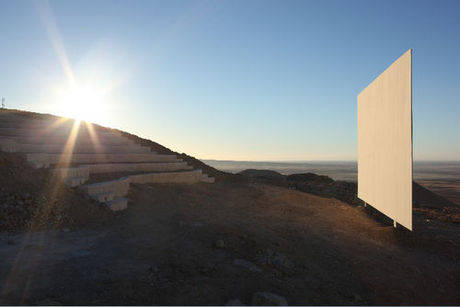Clemens von Wedemeyer
Sep 13–16, 2012
SEE TRAILER
Sun Cinema, Mardin, Turkey, 2010
MARDIN CINEMA ASSOCIATION ON FACEBOOK
Text by November Paynter and Clemens von Wedemeyer
Mardin is situated on a hill overlooking the Mesopotamien plain, and is regarded as a “city of light”. Recent archeological excavations have found an ancient pagan sun temple underneath a monastery and the city itself is trying to b come a UNESCO heritage site. In terms of the cultural sector, a museum and a cinema were recently built and a film festival has been running for 2 years. But, before this cinema was completed Mardin had no projection space for some time as the previous cinema had gone bankrupt. At the outset of his My City project for Mardin Clemens realised that it would be interesting to contribute to this new cinematic endeavour, because as he describes: “a cinema can contribute a different, or a third form of cultural arena”. He adds: “Mardin’s historical buildings are the city’s main visitor attractions and as these are renovated in the hope of creating a new touristic museum context, in which parts are rebuilt and others demolished, it seems fitting that public space is incorporated”.
All these thoughts have fed into Clemens’ idea to create a “screen of desire” that he will locate in Mardin as a statement of potentiality. This screen, in its first sketchups, alluded
to the one built by the architect Le Corbusier atop his infamous modernist residential project Unite d’Habitation in Marseille, France (1947-52). Le Corbusier’s idealist community proposal can be imagined as the perfect, classic, public cinema. Since Clemens’ first observations of the historical stone constructions of Mardin and his ideas of trying to create a cinema that could have been imagined as part of the city’s history, the project has developed to focus more on how a modernist structure would function in the city.
Cinema was invented at the end of the 19th century, but also the Laterna Magica, the Camera Obscura, The Turkish Shadow Theatre etc. used light to entertain. Therefore the “principle of cinema” is much older than we immediately recognize. It is as old as the light of the sun, which has always created images of bright and dark in our memory. “That is why cinema is not dead when the video projectors conquer the scene.” (Alexander Kluge). Both the idea of creating a new public space for the city of Mardin as well as connecting cinema to the sun, has lead Clemens to form a research project on the sun and cinema in relation to the region of Mardin, which is presented here for the first time on the next pages. This research was used as a basis for a workshop with a group of architects in Istanbul to develop a final design for a screen that will fit into the Mardin context as a current addition to its layers of history and that reflects the basic elements of an open-air cinema venue.
Initially, a plinth with a projector will stand opposite the monolith screen and projections will occur after dusk. But Clemens is very clear that he does not want to create something that has one function and meaning alone, and that what he produces should be open to interpretation and use. After an initial screening program that will include Clemens’ own video work, as well as other films and videos from the area, it is possible
that the projector will travel throughout the city to become a moving cinema with a life of its own. The screen meanwhile may continue to be used for film projections, or it may simply sit as a reminder of how a site of public and active space can be created. Located on the west edge of the city, overlooking the plains to the south in Syria, the screen will connect to the sun’s pattern of setting and through this relationship with light and shadow another trope of cinema reveals itself. Regardless of whether there is a projection taking place, the structure will reflect the evening sun back onto the south, via a giant mirror installed on the backside of the screen.
This screen will hopefully introduce a contemporary arena for the city that will exist as a current, valid and active public space for years to come.
RES Art World/World Art, Oktober 2010, Nr. 6
